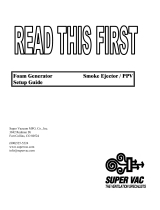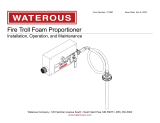
©Copyright Task Force Tips LLC 2010-2021 6 LIU-330 February 15, 2021 Rev09
4.0 OPERATING INSTRUCTIONS
Refer to training approved by the AHJ for appropriate foam type, concentration, and hose length.
1. Choose the appropriate foam concentration.
2. Lay the appropriate hose line.
3. Connect the appropriate nozzle.
4. Charge the hose and open the nozzle fully to establish the water flow.
5. Adjust the pump pressure so the eductor inlet is set at pressure specified on body label.
6. Rotate the percentage knob to the desired concentration.
7. Place the concentrate intake wand in the foam supply.
4.1 CLEANING INSTRUCTIONS
The eductor must be cleaned after each use to prevent residual foam concentrate from clogging the passageways.
1. After use, take the concentrate intake hose out of the foam supply.
2. Turn down the pump pressure to below 75 psi (5.2 bar).
3. Shut off the nozzle.
4. Restrain the wand and expect a rapid discharge of water, especially at the 6% setting.
5. Push the red flush button to run fresh water through the hose and metering head on each setting until there is no visible foam in
the flush water.
6. Retract the lock ring to remove the metering head.
7. Turn off water supply and remove the eductor from the hose so that any remaining foam residue can be washed from the wand,
metering head and eductor.
5.0 USE WITH FOAM
5.1 FOAM SELECTION
Actual foam concentrations vary with changes in water flow, foam concentrate temperature and viscosity. The user must verify that the
concentrate’s performance is suitable for use in their application. Refer to training approved by the AHJ regarding foam concentrate use.
In all cases, the manufacturer’s recommendations must be followed.
5.2 FOAM ATTACHMENT OPTIONS
Expansion ratios vary depending on the type of nozzle used. Refer to training approved by the AHJ when choosing a foam nozzle or
attachment.
Medium Expansion Nozzle — produces the greatest expansion ratios. It is generally used on Class B fuels for vapor suppression and
Class A fuels when a longer lasting insulating layer of drier foam is desired.
Low Expansion Nozzle — can be used with either Class A or B foam solutions. Reach is slightly less than the smooth bore. It is
generally used on Class B fires for extinguishment and Class A fuels to soak the fuel with a wet foam solution.
Straight Stream Nozzle — is for Class A foam solutions. Foam expansion will be negligible. For use where maximum reach or
penetration is desired.
CAUTION Rapid backflush discharge from the wand could cause injury.
The backflush push button is pressure activated and must not be forced at pressures over 75 psi (5
bar). Do not backflush above 75 psi.
CAUTION Mixing of foam concentrates can cause the contents of the foam tank to gel and produce
unpredictable results. To reduce the risk of injury due to unpredictable foam production:
• Do not mix different types of foam concentrates or foams of the same type from different
manufacturers.
• Clean tank and foam passages thoroughly when changing foam types.



















